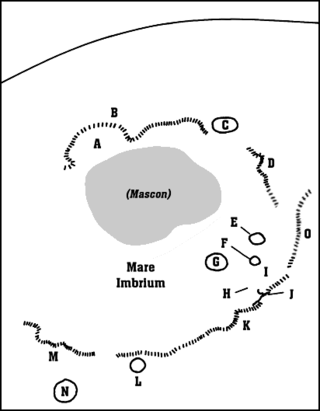Loading AI tools
Mountain range on the Moon From Wikipedia, the free encyclopedia
Montes Apenninus are a rugged mountain range on the northern part of the Moon's near side. They are named after the Apennine Mountains in Italy. With their formation dating back about 3.9 billion years, Montes Apenninus are fairly old.
| Montes Apenninus | |
|---|---|
 LRO image | |
| Highest point | |
| Listing | Lunar mountains |
| Coordinates | 20°N 3°W |
| Naming | |
| English translation | Apennine Mountains |
| Geography | |
 | |
| Location | Moon |

Montes Apenninus is the most prominent remnant of the outer ring of the Imbrium basin, which also includes Montes Carpatus to its south and Montes Caucasus to its north.
The Montes Apenninus range forms the southeastern border of the large Mare Imbrium lunar mare and the northwestern border of the Terra Nivium highland region. It begins just to the west of the prominent crater Eratosthenes, which abuts against the southern face of the range. To the west of these mountains is a narrow gap where Mare Imbrium in the north joins Mare Insularum to the south. Further to the west are the Montes Carpatus mountains.

From Eratosthenes, the mountains form an arcing chain that gradually bends from east to northeast, ending at Promontorium Fresnel at about latitude 29.5° N. Here is another gap where the Mare Imbrium to the west joins the Mare Serenitatis to the east. At the north end of this gap lie the Montes Caucasus.[1]
This range contains several mountains that have received names, listed below ranging from west to northeast:
The last two peaks form the valley where the Apollo 15 mission made its landing. This landing was considered one of the most scientifically successful missions of the Apollo program and started the last three J-Series missions that included the lunar rover and 3-day stays. Apollo 15 explored smaller peak Mons Hadley Delta (δ) and Rima Hadley rille. This was considered the most geologically diverse landing site of the program.[3]
Montes Apenninus forms a sharp, rugged rise at the edge of the Mare Imbrium. The total length of the range is about 600 km (370 mi), with some of the peaks rising as high as 5 km (3.1 mi). The entire area to the southeast of Montes Apenninus - its backslopes - is shaped by ejecta deposited during the violent uplift of the mountains.[4] Sections of the Montes Apenninus front are also rubbly, a result of both fallback ejecta and landslides from the newly formed peaks.




Seamless Wikipedia browsing. On steroids.
Every time you click a link to Wikipedia, Wiktionary or Wikiquote in your browser's search results, it will show the modern Wikiwand interface.
Wikiwand extension is a five stars, simple, with minimum permission required to keep your browsing private, safe and transparent.